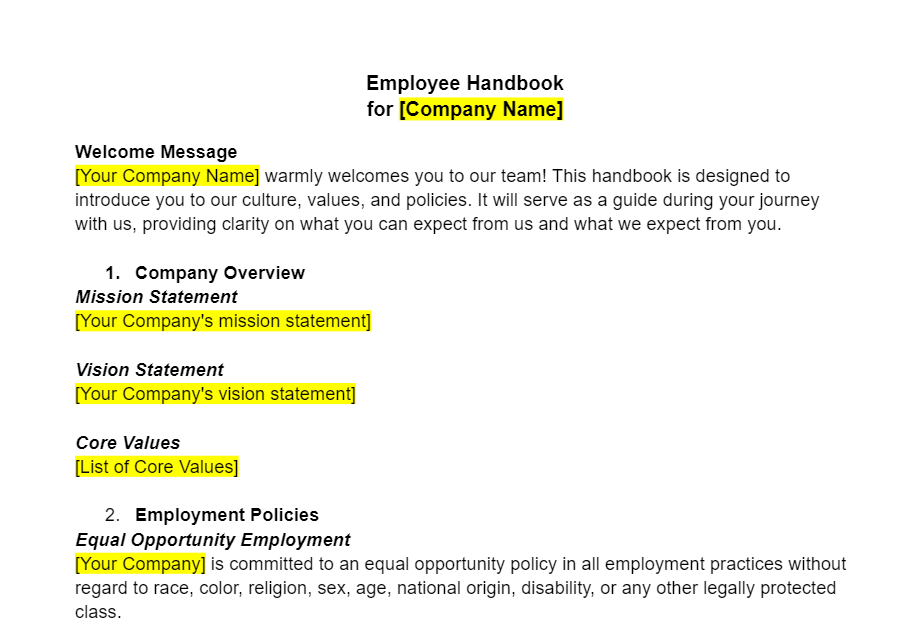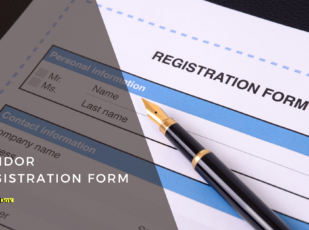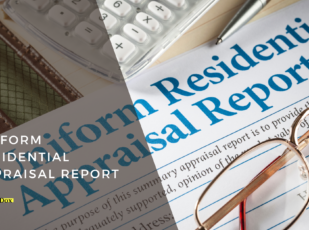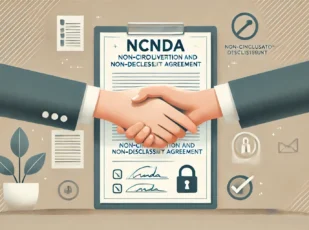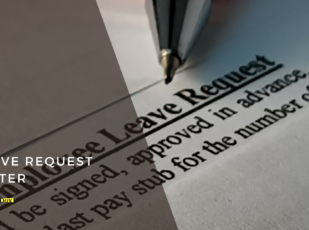
Employee Handbook Template
13 Downloads
Administrative Law, Corporate, Employment
December 23, 2024
Sayantani Dutta
An employee handbook establishes the business systems framework for workplace policies in the employer-employee relationship.
Essentially, if a new employee arrives at the company, they get their handbook, and that’s everything they need to settle into their role in the firm and thrive. It’s a vital part of training and onboarding and a key document for maintaining governance in the workplace.
The handbook not only benefits employees but also offers legal protection to the business. Some states view issuing an employee handbook and collecting the acknowledgment from the employee as a binding legal agreement and as good as signing an employment contract.
What are the Contents of the Employee Handbook?
The handbook should be easy to read and cover issues involving compliance and the employer’s legal obligations to the employees. Companies that decide to include an employee handbook in their systems mitigate a significant amount of risk attached to hiring people and complying with labor laws.
The handbook should cultivate an employment-at-will culture with employees. Include a description of the at-will relationship and the proper disclaimers in the “Acknowledgment of Receipt of Handbook” the employee signs when receiving it.
The handbook outlines the company’s intention to remain compliant with relevant labor laws, such as the Fair Labor Standards Act. It outlines if the company is an equal opportunity employer and irons out issues regarding pay and compliance with reasonable accommodations offered. The handbook offers support or grounds for employment decisions; for example, the employee’s violation of work rules may result in their termination from the company.
The handbook is an official company document and covers employee duties and responsibilities. The employer must seek legal advice when structuring each clause, especially with regard to anti-discrimination policies, workplace safety, and employment laws, like the Equal Employment Opportunity Commission (EEOC) and the Family and Medical Leave Act (FMLA).
What Are the Provisions in the Employee Handbook?
Here is a quick look at the table of contents you’ll find in a standard employee handbook.
- Company overview and history.
- Equal Opportunity Employer policies.
- Code of conduct (dress code, attendance, safety, and code of ethics).
- Worker’s compensation policy.
- Health and safety policies.
- Non-discrimination policies.
- Employment and termination policies.
- Compensation and benefits policies.
- Family medical leave policy.
- Vacation policy.
- Confidentiality policy.
The employee can refer to the handbook for guidance if they have a query regarding the company employment policy. Let’s unpack the specifics of the content in the employee handbook.
Defining the Employee Handbook’s Purpose
The handbook provides employees with a resource on the company’s policies and procedures. It gives the employee an idea of what their employer expects from them and how to conduct themselves in the workplace.
General Employment Information
Employers must get legal advice when forming their employment policies. A qualified attorney helps the company maintain compliance with local, state, and federal workplace regulations. The handbook should have the following policies in place:
- Equal Opportunity Employment.
- Non-harassment.
- Non-discrimination.
- Employee eligibility.
The core of the employee handbook involves establishing the company’s procedures and policies for part-time and full-time employees. The employer must include details on standards of conduct, paid time, overtime pay, timekeeping of work hours during the workweek, remote work policies, dress code, promotions, and any other policies and procedures relevant to the business.
Leave Policies
The employee handbook must clearly outline the employee’s leave benefits. This provision should include the employer’s policies on vacation, paid time off, sick leave, bereavement leave, jury duty, maternity/paternity, caregiving, military, and non-exempt employees. The employer should also include the right to terminate any company employee who takes excessive leave from the company.
Health and Safety
The handbook must cover security and safety measures in the work environment while the employee is on company property. Once again, the employer must contact a reputable, experienced attorney. They’ll need legal advice on navigating the challenges of compliance with reporting procedures for injuries, accidents, and health and safety issues on-site. The handbook also addresses bad weather and emergency policies.
Employee Benefits
The handbook must explain, in detail, the employee benefits. Health insurance, social security, 401(k) plans, or employer retirement contributions should all be mentioned in this section, with clear instructions on who to contact at human resources for queries on eligibility requirements.
Employee Termination and Disciplinary Policies
This section protects the employer from employee misconduct, outlining the company policies on disciplinary action for sexual harassment, conflict of interest, non-disclosure, and disciplinary and termination procedures. This section of the handbook mentions conditions for termination of employment and includes the company’s social media policies for employee engagement with the firm online. This section may also mention how often the employee will undergo performance reviews and what’s expected of them by the employer in terms of their workplace efforts.
Acknowledgment
This section is a form the employee signs when receiving the handbook, confirming their commitment to living up to the procedures and policies laid out in the document. The employer collects the acknowledgment and stores it in the employee’s personnel file.
Disclaimer
This section of the handbook states the handbook’s non-contractual purpose and maintains the “at-will” status of employment with the company. This section offers a critical defense if the employee sues the company for violating a clause in the handbook, claiming the document is a contractual obligation.
How to Write an Employee Handbook
The tone of the handbook should emulate the company culture. For instance, you can expect the tone of a law firm employee handbook to be slightly more professional than the casual tone used in many handbooks written by tech companies.
Consider the layout, format, and audience when writing the handbook, and use a template to write the book as a digital document. It makes it so much easier to update the document and distribute it to the employees.
Printed employee handbooks are a nice thing to have. The issue is that they cost resources to produce and require replacing every time you update the handbook, which can be quite often in fast-growing companies.
Employee Handbook Vs. Operations Manual
The operations or procedures manual is a different document from the employee handbook. Managers, HR, and supervisors receive the operations manual. This document covers the implementation and enforcement of company policies and might include sample documents, checklists, and forms managers and HR use when handling specific situations in the workplace. For instance, it may cover how to handle violations of the company’s anti-harassment policy.
The procedures manual tells HR how to handle both sides of the accusation and what disciplinary actions management is to take against an employee if found guilty of the charge. The procedures manual also covers issues like how to complete Form I-9, the procedures for sending out an offer letter or handling requests for leave. The handbook may also reference laws and regulations HR can look up to resolve certain situations.
Like the employee handbook, there’s no law forcing companies to create this document. However, the procedures manual acts as a reference tool managers can lean on when interacting with existing employees and new hires to ensure consistency in policy enforcement across the entire workforce. It’s also useful for maintaining procedural continuity in HR departments.
Customize Your Company Policies with a Free Employee Handbook Template At FreshDox
The Employee Handbook sets the standards of employment between the employer and employee. It’s a fundamental document every business needs, regardless if there isn’t a legal obligation to create it. Every business is unique in terms of its mission, company values, and culture; your employee handbook needs to be a flexible document you can update.
FreshDox offers you a completely customizable Employee Handbook Template for your business. Edit your template digitally and distribute it via email or print out a physical copy for your employees. Download it with a free 7-day trial of a Basic or Premium account.
Related Templates
Discover more templates that align with your needs and preferences.

Ready to Sign Up?
Sign up for FreshDox.com’s 7-day trial and discover why so many individuals and businesses trust us for their legal document template needs.
- Cancel any time
- 7-day free trial
- From 300+ Customer Reviews

